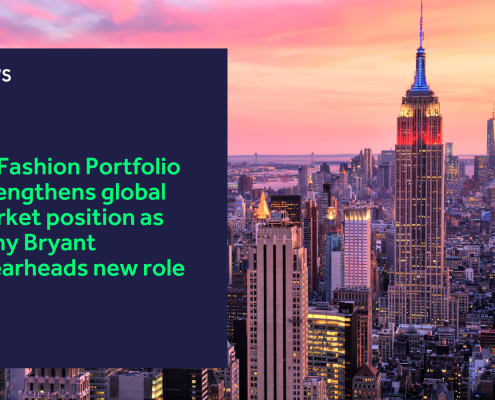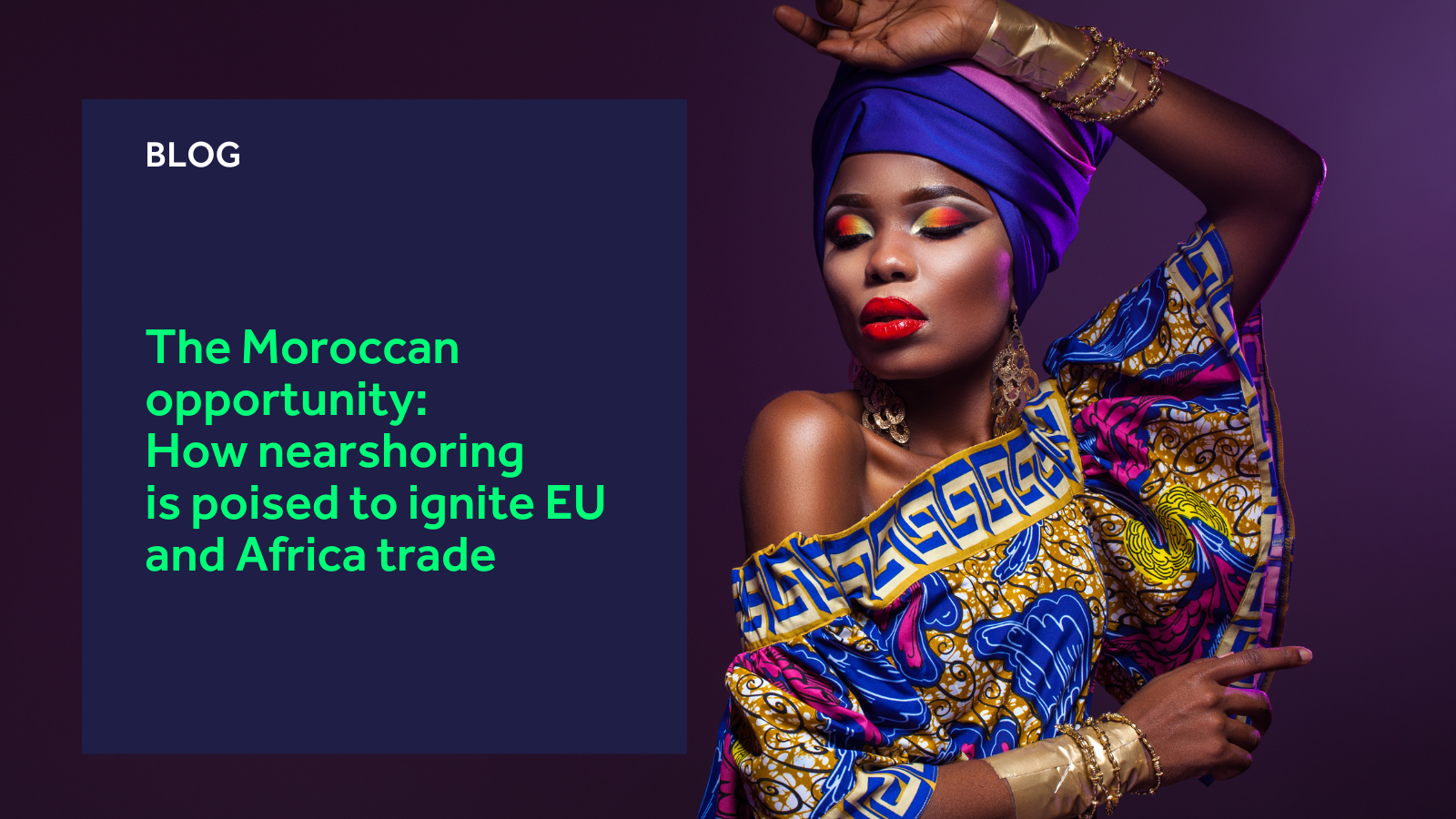The fashion industry is abuzz with the nearshoring trend as companies across the globe look to minimise their exposure to supply chain disruptions and capitalise on new markets.
While significant attention has been given to Mexico and Central America, two key players in the nearshoring shift for North America, little has been discussed about the role Morocco can play on the European side.
Why is nearshoring on the rise?
Nearshoring, the practice of relocating business operations to countries closer to the brand’s home market, provides several strategic advantages tied to proximity and robust industry infrastructures.
With demand volatility, geopolitical tensions, and rising costs continuing to ripple throughout supply chains, traditional linear supply chain models, heavily reliant on distant manufacturing hubs, have proven inadequate.
For decades, fashion and apparel brands pursued offshoring strategies by relocating their production to low-cost Asian labour markets to capitalise on cost efficiencies.
McKinsey has discussed how, in the 2000s and 2010s, companies developed expansive supply chains in regions like Southeast Asia to leverage affordable manufacturing hubs.
However, wages have risen in these countries, shifting the search for low-cost production towards South Asia and parts of Africa. But this model, chasing low labour costs, has proven unsustainable.
Suppliers in traditional hubs like China and Southeast Asia have invested heavily in enhancing productivity through lean manufacturing principles, automation, and other initiatives to retain cost competitiveness.
Consequently, the advantages of labour arbitrage have diminished, driving companies to rethink their global sourcing strategies. This, paired with exorbitant lead times caused by disruption, has caused a boom in nearshoring as a means to capitalise on shorter supply chains.
Why Morocco?
Morocco offers a unique opportunity for textile manufacturers operating in Europe. The country’s proximity to the continent is one of the most significant advantages, enabling shorter lead times and lower transportation costs compared to traditional Asian markets.
Bordered by the Mediterranean Sea and the Atlantic Ocean, Morocco faces Spain directly across the Strait of Gibraltar and is home to the Tanger Med Port — one of the largest ports in Africa — situated just nine miles from Europe.
The port provides a dedicated textile corridor and boasts efficient customs procedures, allowing goods to clear customs in less than an hour in some cases.
These factors are attractive due to the easy access to European countries. This is bolstered by the fact that Morocco has numerous trade agreements with the EU, the US, and African countries.
The EU-Morocco Association Agreement, for instance, grants Moroccan products preferential access to European markets. Likewise, the African Continental Free Trade Area (AfCFTA) agreement opens up opportunities for increased trade within Africa.
Crucially, these agreements position Morocco as a strategic bridge between European and African markets, offering unparalleled access to diverse consumers.
While Morocco may only now be emerging as a key player in nearshoring, it already has a well-established textile industry. More than 1,600 companies produce approximately one billion pieces annually in the country.
The sector employs roughly 27% of the country’s industrial workforce and generates significant export revenue. This extensive industrial base provides the necessary capacity and expertise to meet the demands of international brands, and the country is still investing heavily in modernising the infrastructure.
Back in 2017, the Moroccan government and China’s Haite Group announced plans to launch an industrial park near Tangiers. The “Mohamed VI Tangier Tech City” had an initial investment of $1 billion and aimed to generate 100,000 jobs – including 90,000 for employees from the Tangiers area.
The project was scheduled to take 10 years and is still in progress, serving as the North Africa base for Chinese companies operating in automobile manufacturing, aeronautics, and textiles.
Additionally, the AMITH published a strategic roadmap for the textile industry in 2021, aiming to increase the value of the sector’s exports to $6 billion by 2035 and ensure that 60% of all production is dedicated to co-contracting and finished products, compared to the current 35%.
Which brands are nearshoring in Morocco already?
There are many notable brands which have increased their nearshoring activities in Morocco.
For instance, Decathlon has quintupled its production in the country. In the last two decades, Decathlon had actually reduced its orders from Moroccan suppliers by five times but is now reversing its course with plans to pass approximately $100 million in orders from Moroccan manufacturers.
After investing heavily in Southeast Asia, especially China, with four proprietary factories, 500 suppliers, and four logistics hubs, Decathlon must now contend with mounting pressures to address the environmental impact of sourcing from far-away regions.
Given that Europe is Decathlon’s primary market, Morocco and Tunisia have become key countries for nearshoring practices due to their proximity.
Two other major companies, Asos and Boohoo, also ramped up their production in Morocco following the attacks on container ships in the Red Sea and Suez Canal routes earlier this year.
The attacks led to longer lead times and inflated prices due to the rerouting associated with goods being shipped from Asia. As a result, Asos and Boohoo began to increase sourcing in Morocco, Turkey, and the UK to circumvent these challenges.
According to Retail Week, Asos reportedly said that it still used the Suez Canal route for ocean freight shipments of longer lead products from Asia to Europe, reserving the use of faster routes for its trend-driven seasonal lines that require quick shipment.
Decathlon, Asos, and Boohoo are just three examples of brands that are looking towards Morocco as a buffer against disruption and sustainability concerns, with many more following suit. That said, there are still challenges that need to be addressed.
What are the limitations of nearshoring in Morocco?
Chiefly, there are potential language barriers, with Arabic being the official language used in government and everyday life. French is also widely used in business settings due to Morocco’s historical ties with France.
While French companies will be able to nearshore in Morocco more easily, there are indeed language concerns for other businesses. English proficiency, which is often crucial for international business, is improving in Morocco but is not widespread, particularly outside major urban centres. This isn’t a categorical blocker, but it does mean that language support and translations for technical documentation will be required.
Additionally, while Morocco’s textile industry is well-established, some infrastructure challenges remain. Textile manufacturing is energy-intensive, and parts of Morocco are prone to electricity supply issues that could impact production efficiency. Regarding transportation, major ports like Tangier Med are very attractive, but inland transportation is still being developed. Significant work has been done around these areas, so they will improve in the years to come.
Like in many emerging markets, there are likely challenges related to the adoption of cutting-edge technologies and training for sustainable and eco-friendly textile production. Much emphasis is being placed on sustainable materials within Morocco to lessen this challenge.
Legal and regulatory requirements are another consideration for companies looking to nearshore in Morocco. Textile-specific regulations, such as those pertaining to chemical use, worker safety, and environmental protection, could be complex. Compliance with international standards like REACH regulations for exports to the EU could be another challenge.
Finally, and as with any country, while Morocco is relatively stable, textile manufacturing is heavily export-oriented and thus sensitive to changes in trade agreements and currency fluctuations.
Morocco is poised to ignite trade between the EU and Africa
Make no mistake – the nearshoring opportunity in Morocco presents transformative potential for the textile industry. Despite the challenges, it offers genuine promise to foster stronger EU-Africa trade relations.
Morocco’s unique position as a gateway between Europe and Africa makes it an ideal destination for brands seeking to diversify their sourcing strategies and secure a competitive advantage in the global market.
The future of the textile industry lies in agile, sustainable, and collaborative practices. Much like Mexico, nearshoring in Morocco is a step in the right direction.
How can K3 support nearshoring in Morocco?
At K3, we support companies in all facets of fashion, offering comprehensive support for all key operational areas. It doesn’t matter whether you’re a brand or manufacturer — we can help!
For instance, K3 Fashion enables you to break down purchase order quantities into raw material needs to pre-inform manufacturers of the materials needed for production without needing to go into a production modus.
The solution’s Bill of Materials functionality makes it considerably easier to relay specifications to manufacturers, while the procurement features help with managing production progress.
These features combine to streamline processes and ensure that nothing goes amiss, even with potential language barriers. The system is also available in French to further help with this aspect.
To assist with logistics, we offer prepacks, which are effectively full boxes of SKUs that can be moved through the supply chain more efficiently. Prepacks can be predefined size breakdowns, assortments, or sets for added flexibility and efficiency.
Furthermore, while traditional ERP environments don’t support quality control until the end of production, our enhancements to Dynamics 365 Finance and Supply Chain Management do.
While standard D365 F&SCM only supports quality control at the end of the production process when goods have been received, K3 Fashion integrates the process throughout all stages.
The embedded solution enables continuous quality checks, ensuring issues are identified and rectified swiftly, helping to reduce waste and enhance overall productivity while adhering to standards like REACH.
For example, K3 Fashion supports the creation of proto-samples, salesman samples, and other pre-production samples, enabling thorough quality assessment before mass production.
Similarly, our K3 Pebblestone solution provides some of the functionality described above but also offers robust Landed Cost and Cargo Management support.
K3 Landed Cost enables companies to effectively manage and analyse pricing strategies, cost calculations, margins, discounts and other crucial aspects related to pricing and costing.
Meanwhile, Cargo Management empowers businesses to oversee, manage, and distribute their cargo to warehouses with simple-to-use features. The fashion-specific functionality for inventory and warehouse management streamlines processes, improves visibility, and enables efficient tracking of goods throughout the supply chain.
Finally, our CSR module, available in both K3 Fashion and K3 Pebblestone, provides classifications and certificates on raw materials and suppliers, allowing businesses to choose the options that best meet their specific policies. Transactions can even be blocked with those who do not fall in line with these policies.
Equipped with the CSR module, companies concerned about eco-friendly materials can look to set up shop in Morocco more confidently.
This is just a small sample of how we can help you. If you’d like to learn more, feel free to drop us a line today.
 https://www.k3btg.com/wp-content/uploads/2024/03/K3-strengthens-global-market-position-blog-header.png
900
1600
Jordan Heal
https://www.k3btg.com/wp-content/uploads/2022/03/K3_Master_Colour_RGB.svg
Jordan Heal2024-03-11 10:58:242025-02-21 14:37:51K3 Fashion Portfolio strengthens global market position as Tony Bryant spearheads new role
https://www.k3btg.com/wp-content/uploads/2024/03/K3-strengthens-global-market-position-blog-header.png
900
1600
Jordan Heal
https://www.k3btg.com/wp-content/uploads/2022/03/K3_Master_Colour_RGB.svg
Jordan Heal2024-03-11 10:58:242025-02-21 14:37:51K3 Fashion Portfolio strengthens global market position as Tony Bryant spearheads new role

